
sphagnum-moss-26610402.jpg from: https://www.dreamstime.com/stock-photography-sphagnum-moss-image26610402
Exploring the Fascinating World of Sphagnum aongstroemii C.Hartm. Moss
Sphagnum aongstroemii C.Hartm. is a remarkable species of moss belonging to the Sphagnaceae family, commonly known as Sphagnum or peat moss. This tiny but mighty plant plays a crucial role in its ecosystem and has some amazing adaptations. Let’s dive in and learn more about this fascinating moss!

sphagnum3_934c207f-91bb-4ccc-9a69-3cb114b7c7b9_1491x1930.jpg from: https://pistilsnursery.com/collections/for-your-plants/products/sphagnum-moss
Background on Sphagnum Mosses
Sphagnum mosses are unique non-vascular plants in the phylum Bryophyta and class Sphagnopsida. There are around 380 Sphagnum species worldwide, typically found in bogs, fens, and other wetland habitats. Sphagnum mosses lack roots and instead absorb water and nutrients directly through their leaves and stems.
Morphology and Identification
S. aongstroemii has distinctive morphological features:
- Compact capitula (head-like clusters of branches)
- Stem leaves with a broadly rounded apex
- Branch leaves are ovate to lanceolate in shape
- Pale green to yellowish color
Careful examination of leaf shape, branch arrangement, and color is key for proper identification of this Sphagnum species.
Global Distribution and Habitat
S. aongstroemii has a circumboreal distribution, found in northern regions of North America, Europe, and Asia. It typically grows in:
- Ombrotrophic (rain-fed) bogs
- Poor fens with low nutrient levels
- Tundra and boreal forest wetlands
This moss prefers acidic, waterlogged substrates and cool temperatures.
Ecological Roles and Adaptations
S. aongstroemii plays vital roles in its wetland ecosystems:
- Peat formation – Dead Sphagnum accumulates as peat, storing carbon
- Water retention – Holds up to 20x its dry weight in water
- Acidifies habitat – Cation exchange lowers pH
- Nutrient-poor conditions – Outcompetes other plants
Unique adaptations allow it to thrive:
- Hyaline cells for water/nutrient storage
- Antibiotic sphagnan inhibits bacterial decay
- Grows from apex, avoiding burial by peat
Conclusion
Sphagnum aongstroemii C.Hartm. is a small but incredibly important moss with a big impact on its environment. From carbon storage to water retention to engineering habitat conditions, this mighty moss is a key player in boreal and arctic wetland ecosystems. Next time you’re in a northern bog, take a closer look and appreciate the power of Sphagnum!